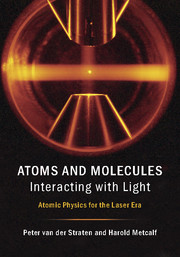Book contents
- Frontmatter
- Contents
- Preface
- Part I Atom–light interaction
- 1 The classical physics pathway
- 2 Interaction of two-level atoms and light
- 3 The atom–light interaction
- 4 “Forbidden” transitions
- 5 Spontaneous emission
- 6 The density matrix
- Part II Internal structure
- Part III Applications
- Part IV Appendix
- References
- Index
4 - “Forbidden” transitions
from Part I - Atom–light interaction
Published online by Cambridge University Press: 05 February 2016
- Frontmatter
- Contents
- Preface
- Part I Atom–light interaction
- 1 The classical physics pathway
- 2 Interaction of two-level atoms and light
- 3 The atom–light interaction
- 4 “Forbidden” transitions
- 5 Spontaneous emission
- 6 The density matrix
- Part II Internal structure
- Part III Applications
- Part IV Appendix
- References
- Index
Summary
Introduction
The selection rules discussed in Sec. 3.5 forbid many kinds of transitions that are frequently observed or exploited. It must be remembered that these “rules” are based on the approximations of Sec. 3.2, but of course, those can be extended. Such expansions to higher orders of approximation may seem to be little more than a tedious exercise, but this chapter will show that the results are extremely important, because they cause qualitatively different kinds of transitions. Since they involve both the electric and magnetic components of the light, their atomic dipole moments will be identified with the superscript E and B for the remainder of this chapter. The magnetic dipole transitions, called M1, discussed in Sec. 4.2.1 that arise from extension of the electric dipole approximation encompass all of magnetic resonance, including atomic clocks, forced evaporative cooling in Bose–Einstein Condensation (BEC), MRI, and astrophysical processes such as generation of the all-important 21 cm radio frequency line. The electric quadrupole transitions, called E2, discussed in Sec. 4.2.2 describe myriad stellar spectral features as well as the vast majority of nuclear γ-ray transitions.
Even with these extensions there are many cases where the relaxation of the electric dipole (E1) selection rules to include M1 and E2 transitions as in Sec. 4.2 still do not account for observed processes. Thus other approximations have to be extended so that their limitations can be relaxed as well. Extension of the perturbation approximation (see Sec. 4.3.1) provides an analytical description of most of non-linear optics, including second harmonic generation, four wave mixing, Raman spectroscopy, and the fabled decay of the hydrogen 2S state.
A semi-classical description of the interaction between radiation and atoms can begin with a multipole expansion of the Hamiltonian. The lowest-order term is just from the point charges α located at, and vanishes for neutral atoms. The next-order term is the electric dipole interaction that arises from the non-isotropic distribution of charges induced by the electric field of the light. This term produces the electric dipole transitions (E1) that have been described in some detail in Chap. 3.
- Type
- Chapter
- Information
- Atoms and Molecules Interacting with LightAtomic Physics for the Laser Era, pp. 64 - 79Publisher: Cambridge University PressPrint publication year: 2016



